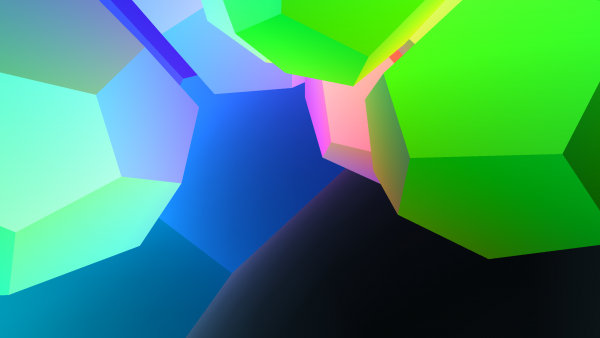
Vi Hart, Andrea Hawksley, Henry Segerman and Marc ten Bosch each independently have long track records of doing crazy, innovative stuff with maths. Together, they’ve made Hypernom.
Hypernom is a game where you nom cells of four-dimensional objects by rotating, wiggling and twisting yourself around to move through a stereographic projection of a radial projection of a 4D polytope. It looks like this:

While from the outside it looks like this:

(That’s one of the creators of the game, Vi Hart, committing fully to the nom.)
I’ll make an attempt to explain the maths of what’s going on in the game. (Or you might just be better off reading the explanation in the paper, “Hypernom: Mapping VR Headset Orientation to $S^3$”) A polytope is a higher-dimensional analogue of a polyhedron: it sits in $n$-dimensional space, and its “sides” (also called cells) are flat $n-1$-dimensional objects. In Hypernom, you’re nomming up regular 4D polytopes, whose cells are regular 3D polyhedra.
In order to display the 4D shapes, you need to project them onto 3D space (like a shadow is the 2D projection of a 3D shape). Hypernom first radially projects the polytope onto a 4D hypersphere $S^3$ (that’s a 3 not a 4 because “sphere” means the edge, or shell, of a ball. The boundary of a 4D ball has three dimensions). Each cell of the polytope fills up a region of the sphere. That sphere is then stereographically projected into normal 3D space: the stereographic projection picks one origin point and a 3D hyperplane (imagine 3D space, but it also has a particular position in the fourth dimension), then projects each point on the hypersphere to the point where the line from the origin intersects the hyperplane.
That’s hard to imagine, so here’s a video Henry Segerman made to explain stereographic projection from 3D into 2D:
Segerman explains the 4D version of that in a paper titled “Sculptures in $S^3$”.
The next question is how you move through this space. Hart and co. have cleverly noticed that $SO(3)$, the set of orientations in three-dimensional space, is double covered by $S^3$, the set of points on the edge of a four-dimensional sphere – that is, for every orientation in 3D space, there are exactly two corresponding points on the 4D sphere.
Hypernom maps the orientation of your screen to a unit quaternion, which corresponds to a point of $S^3$. So, by wiggling around, you spin this four-dimensional ball, which looks to you like movement through three-dimensional space, and when you get close enough to the centre of a cell you “nom” it and it disappears. It’s designed for VR goggles, though it can also use your phone’s orientation sensor; I did a lot of twirling when playing on my phone, which I guess would be quite hard when the thing that needs to be twirled is your whole body. The aim of the game is to nom all the cells of your chosen polytope in as short a time as as possible.
Really, it’s all an excuse to mess about with odd geometry. It’s interesting to see which intuitions about how you move through space break down in this world, and how hard it is to develop new ones. The authors acknowledge this; the “motivation and artistic choices” section of their paper begins,
It may seem somewhat arbitrary to design a VR game that uses headset orientation data as a quaternion to map your position in $S^3$ to eat cells of regular polychora, but given the context of mathematical art and VR research the authors are immersed in, it seemed obvious, even necessary, to design exactly this game.
As for me, I’m curious to see if you can make a game where you only use a few cells, and maybe the aim is to travel from one to the other in a certain order. All the source code to Hypernom is available on GitHub, so maybe I’ll have a go at modifying it to do that.
More information
Explanation, instructions and source code on the Hypernom GitHub page
Hypernom: Mapping VR Headset Orientation to $S^3$ – paper by Vi Hart, Andrea Hawksley, Henry Segerman and Marc ten Bosch.
Sculptures in $S^3$ – paper by Saul Schleimer and Henry Segerman
how Is stereographic projection a map from a sphere to a plain? how does that work?
If the video by Henry Segerman above doesn’t do it for you, try this video by the AMS.
NOM!
Nom? I guess it means eat. But if that’s the case just say eat.